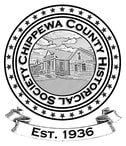On February 12, 1936 the Chippewa County Historical Society was founded by 69 charter members. In 1938, private funds were raised by Dr. Anna Amrud which began the process of restoring the Lac qui Parle Mission. The Lac qui Parle Mission was dedicated on July 12, 1942. It was built on the Mission’s original foundation as a WPA (Works Progress Administration) project, with the combined efforts of the State of Minnesota and the Chippewa County Historical Society.
The organization’s first museum was located in the old Windom College in Montevideo in 1941. Following the demise of Windom College, the Society relocated the museum to the new courthouse in Montevideo where it stayed from 1957 to 1970. The first part time curator, Mrs. Leonard (Doris) Benson was hired in 1959 and served in that capacity until 1976. In 1964, as space became limited at the County Courthouse, the Society began looking for a permanent place to call home. They discovered a 20-acre site known as Wildwood City Park (Hobo Park) and chose this as the site for the future Pioneer Village, now known as Historic Chippewa City. In 1965 the first donated building, the Schoolhouse, was brought into Historic Chippewa City. The school was also known as the Lund-Hendrickson school, District 276 (old District 4). Between 1965 and 1984, twenty-three buildings were brought onto the site to be preserved, or were built on site.
On April 13, 1967, John Swensson bequeathed to the Society his father Olof Swensson’s original farmstead, consisting of 17 acres complete with a 1880s timber-framed barn, grist mill remains, family cemetery, and a 22 room brick farmhouse. The Swensson Farm Museum, was opened to the public later that fall. Benny Anderson was the site’s first caretaker, and then Rowland and Gertrude Norman served in that capacity until 1983.
The organization’s first museum was located in the old Windom College in Montevideo in 1941. Following the demise of Windom College, the Society relocated the museum to the new courthouse in Montevideo where it stayed from 1957 to 1970. The first part time curator, Mrs. Leonard (Doris) Benson was hired in 1959 and served in that capacity until 1976. In 1964, as space became limited at the County Courthouse, the Society began looking for a permanent place to call home. They discovered a 20-acre site known as Wildwood City Park (Hobo Park) and chose this as the site for the future Pioneer Village, now known as Historic Chippewa City. In 1965 the first donated building, the Schoolhouse, was brought into Historic Chippewa City. The school was also known as the Lund-Hendrickson school, District 276 (old District 4). Between 1965 and 1984, twenty-three buildings were brought onto the site to be preserved, or were built on site.
On April 13, 1967, John Swensson bequeathed to the Society his father Olof Swensson’s original farmstead, consisting of 17 acres complete with a 1880s timber-framed barn, grist mill remains, family cemetery, and a 22 room brick farmhouse. The Swensson Farm Museum, was opened to the public later that fall. Benny Anderson was the site’s first caretaker, and then Rowland and Gertrude Norman served in that capacity until 1983.
Chippewa County Historical Society
151 Arnie Anderson Drive
Montevideo, MN 56265
[email protected]
151 Arnie Anderson Drive
Montevideo, MN 56265
[email protected]

